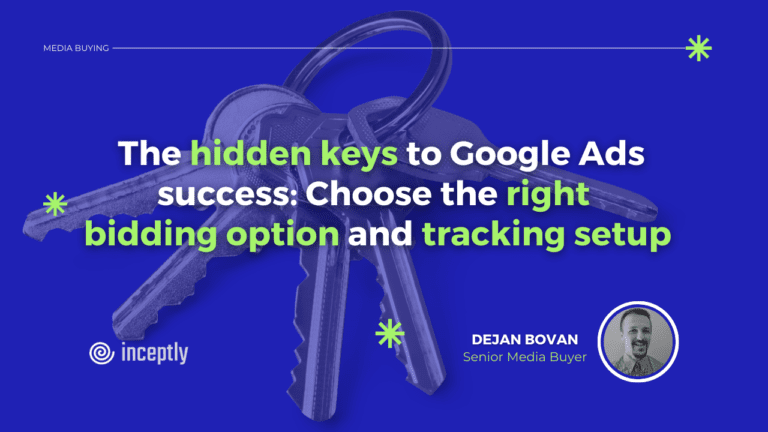
When launching a Google Ads campaign, it’s easy to focus on creative assets and targeting, as these are often seen as the most visible and immediate aspects of a campaign. However, the success of your campaign hinges on more than just eye-catching visuals and pinpoint targeting.
The choice of bidding strategy and the accuracy of your tracking setup are equally, if not more, crucial. These elements can significantly impact the performance of your campaign and the clarity of your results.
Want to brainstorm with our team on new ways to scale your business with YouTube Ads (and other performance video platforms)?
Join us for a free YouTube ad brainstorming session👇
Let’s deep dive…
🔍 Step 1: Ensuring a proper tracking setup
Before diving into bidding options, it’s essential to ensure that your tracking setup is robust and accurate. Proper tracking is the foundation upon which you’ll build your bidding strategy. Without it, you won’t be able to make informed decisions or accurately gauge the success of your campaign.
🔧 What constitutes a proper tracking setup?
- 📊 GA4 property: Setting up a GA4 property is the first step. This ensures that you have a comprehensive view of user interactions across your site and app.
- 🔗 Website tracking for primary and secondary conversions:
- Primary conversions: These are the main actions you want your users to take, such as making a purchase or filling out a lead form.
- Secondary conversions: These actions provide insight into the customer journey. For instance, tracking interactions like:
- 👀 Landing Page View
- 🛒 Add to Cart
- 💳 Begin Checkout
Mapping these secondary conversions allows you to understand the customer journey in detail. This mapping helps identify potential drop-off points and areas for funnel optimization. By analyzing the step-by-step drop-off rates, you can focus on the exact points in the funnel where users might be encountering obstacles.
- 🔄 Main conversion categories:
- ➡️ Initial conversion: The first conversion event (e.g., a purchase).
- ↕️ Upsell/Downsell: Subsequent conversions that involve additional sales opportunities.
🖥️ The role of backend tracking systems
As your ad spend increases, particularly when you’re running campaigns across multiple platforms, website tracking alone might not provide an accurate picture. This is where backend tracking systems come into play. Backend tracking systems like RedTrack, Hyros, TripleWhale, and Everflow are essential for larger campaigns.
- 📈 The challenge of overreporting: As your marketing efforts expand, including channels like Google Ads, Facebook, TikTok, and email marketing, you may notice discrepancies between your CRM and reported conversions. Overreporting becomes a common issue, especially with overlapping ad exposure across different channels.
- 🔍 Identifying underperforming channels: With multiple channels in play, it’s crucial to pinpoint which are driving genuine conversions and which are not. A backend system helps you attribute conversions accurately, giving you a clearer picture of your marketing effectiveness.
🔗 Understanding UTM parameters for effective tracking
To make the most of your backend tracking systems, understanding UTM parameters is key. UTM parameters help track the effectiveness of your campaigns by identifying which source, medium, and campaign drove a user to your site.
- 🔒 Static vs. Dynamic UTM parameters:
- Static UTM parameters: These include parameters like utm_source=google or utm_source=facebook. These are consistent across your campaigns.
- Static UTM parameters: These include parameters like utm_source=google or utm_source=facebook. These are consistent across your campaigns.
- 🔄 Dynamic UTM parameters: These parameters are adjusted automatically by the platform, such as utm_campaign={campaignid} for Google campaigns or campaign_id={{campaign.id}} for Facebook campaigns.
Understanding the difference between static and dynamic UTM parameters allows you to set up your campaigns correctly and ensures that your backend system can accurately attribute conversions to the right source.
- 🚧 Limitations and hierarchies: Each platform has its quirks regarding what can and cannot be passed dynamically. Recognizing these limitations helps you troubleshoot issues more effectively. Additionally, understanding the hierarchy of UTM parameters is crucial for debugging your tracking setup and ensuring accurate data collection.
🎯 Attribution settings and cross-channel performance
Once your tracking setup is solid, you can explore different attribution settings to better understand your campaign’s cross-channel performance. For example:
- 🔍 First-click attribution: This model credits the first interaction a user had with your brand. It might show poorer performance for brand campaigns since brand interactions typically follow cold traffic engagements.
- 🔁 Last-click attribution: This model credits the last interaction before conversion. It’s often more favorable to brand campaigns because it captures the final step before a user converts, often after engaging with your cold traffic ads.
💡 Step 2: Choosing the right bidding option in Google Ads
With your tracking setup in place, the next step is selecting the right bidding option. The bidding strategy you choose will determine how Google Ads spends your budget and reaches your target audience.
⚖️ Maximize conversions (MC) vs. Target CPA (tCPA)
Google Ads offers two primary bidding options when you’re starting:
- 📈 Maximize conversions (MC):
- This option leverages Google’s AI to automatically find the optimal bid for each ad impression, aiming to get the highest number of conversions within your budget.
- It’s particularly useful when you want to ensure that your daily budget is fully utilized. Google’s auction-time bidding capabilities tailor bids for every auction, aiming to get the cheapest conversions available for your budget.
- 🔑 Key consideration: MC is ideal when you’re in a testing phase or when results are favorable and you want to scale up quickly.
- 🎯 Target CPA (tCPA):
- This bidding strategy sets a target cost per acquisition (CPA), and Google Ads adjusts bids to achieve that target across your campaign.
- It uses historical data to predict which impressions are most likely to convert at your target CPA. While some conversions may cost more and others less, the goal is to maintain an average CPA that matches your target.
- 🔑 Key consideration: tCPA is more suitable when your campaign’s performance is close to or slightly below your desired CPA, offering more control over spending.
💰 Budget management in tCPA campaigns
One thing to note with tCPA campaigns is that if your budget wasn’t fully spent on a given day and you decide to increase your bid the next day, Google Ads might spend twice your daily budget. This happens because the increased bid allows Google to compete more aggressively in auctions, leading to higher spending.
🚀 Advanced bidding options: Maximize conversion value and target ROAS
Once your campaign has gathered enough data, you might consider shifting to more advanced bidding strategies like Maximize Conversion Value or Target ROAS:
- 💸 Maximize conversion value: This strategy focuses on getting the highest conversion value for your budget, rather than just the highest number of conversions. It’s ideal for campaigns where the value of conversions varies significantly.
- 📊 Target ROAS (return on ad spend): This strategy sets a target return on ad spend, allowing Google Ads to optimize bids based on expected conversion value relative to cost. It’s useful for campaigns where conversion values fluctuate and you want to maintain a specific profitability level.
🔄 Continuous monitoring and optimization
Regardless of the bidding strategy you choose, continuous monitoring and optimization are essential. Campaign performance can fluctuate due to various factors, such as changes in competition, audience behavior, or seasonality. By regularly reviewing your campaign data and adjusting your bids, targeting, and creatives, you can ensure that your campaign remains aligned with your marketing goals.
In summary, while creative assets and targeting are critical components of any Google Ads campaign, the choice of bidding strategy and the accuracy of your tracking setup are equally vital. A well-thought-out tracking setup allows you to accurately measure and analyze your campaign’s performance, while the right bidding strategy ensures that you’re maximizing your budget’s potential. By focusing on these foundational elements, you can build a more effective and successful Google Ads campaign, driving better results and achieving your marketing objectives.
Want to brainstorm with our team on new ways to scale your business with YouTube Ads (and other performance video platforms)?
Join us for a free YouTube ad brainstorming session👇
Want more content like this?
Don’t miss out on the latest news and updates from the world of Direct Response advertising! Subscribe to our newsletter today 👇

Dejan Bovan, Senior Media Buyer
Having started out at Inceptly as a tracking whizz and a certified GTM, GDS, and Segment expert, Dejan then transitioned into media buying. His background and analytical mindset now help him spot and take advantage of untapped opportunities for our clients.
Like this post? Let's continue the conversation!
Get in touch with us by shooting us a quick email or tagging us on LinkedIn or Instagram, and sharing your thoughts. Your feedback helps us keep our blog relevant and interesting.
Get Our Newsletter
Need Help?
Get in touch with us for an insightful evaluation of your ads + actionable tips to help amp up your direct response revenue



